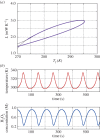Hydrogen peroxide thermochemical oscillator as driver for primordial RNA replication
- PMID: 24647902
- PMCID: PMC4006232
- DOI: 10.1098/rsif.2013.1052
Hydrogen peroxide thermochemical oscillator as driver for primordial RNA replication
Abstract
This paper presents and tests a previously unrecognized mechanism for driving a replicating molecular system on the prebiotic earth. It is proposed that cell-free RNA replication in the primordial soup may have been driven by self-sustained oscillatory thermochemical reactions. To test this hypothesis, a well-characterized hydrogen peroxide oscillator was chosen as the driver and complementary RNA strands with known association and melting kinetics were used as the substrate. An open flow system model for the self-consistent, coupled evolution of the temperature and concentrations in a simple autocatalytic scheme is solved numerically, and it is shown that thermochemical cycling drives replication of the RNA strands. For the (justifiably realistic) values of parameters chosen for the simulated example system, the mean amount of replicant produced at steady state is 6.56 times the input amount, given a constant supply of substrate species. The spontaneous onset of sustained thermochemical oscillations via slowly drifting parameters is demonstrated, and a scheme is given for prebiotic production of complementary RNA strands on rock surfaces.
Keywords: RNA world; prebiotic replication; thermochemical oscillator.
Figures





References
-
- Matatov YI. 1980. Study of the abiotic synthesis of amino acids during the polycondensation of formaldehyde and hydroxylamine. Z. Evol. Bio. Fiz. 16, 189–193. [In Russian with English abstract.] - PubMed
Publication types
MeSH terms
Substances
LinkOut - more resources
Full Text Sources
Other Literature Sources

